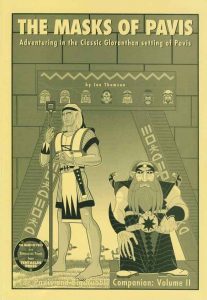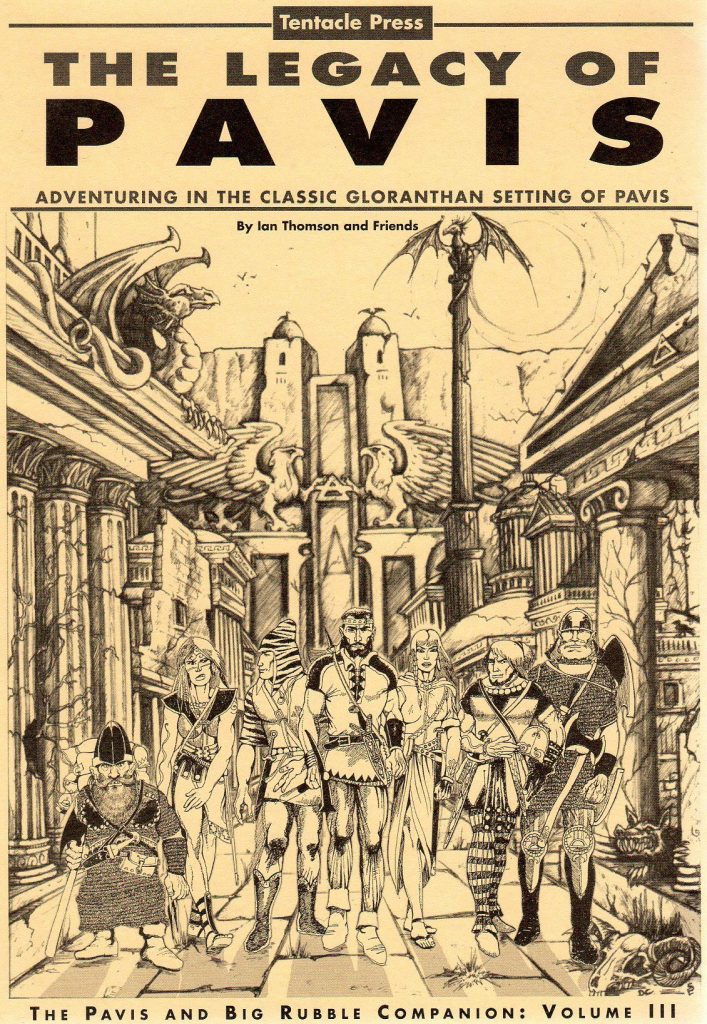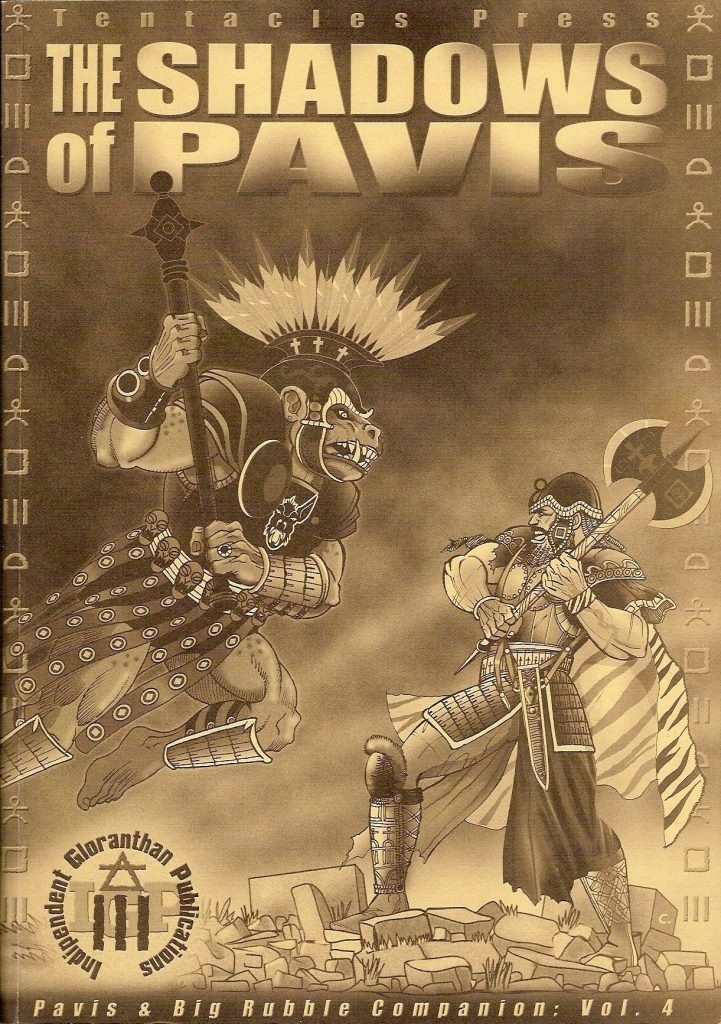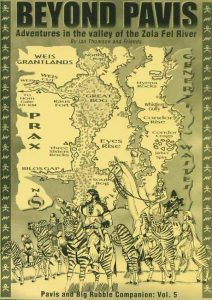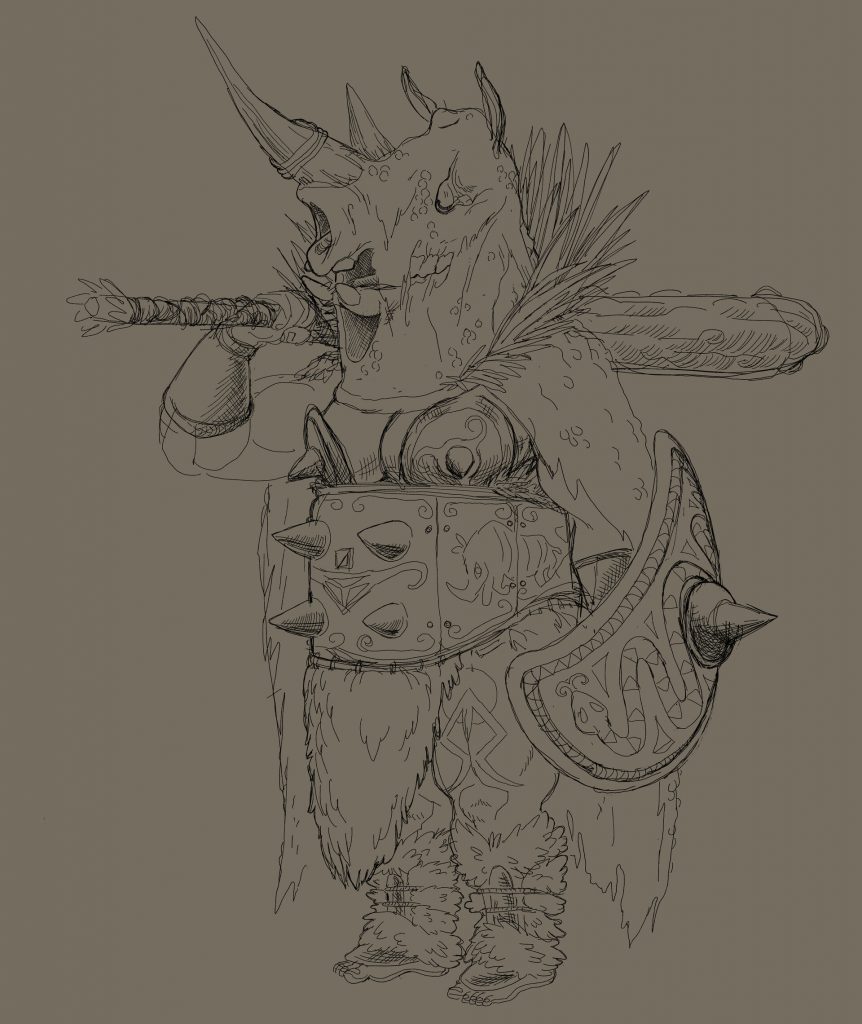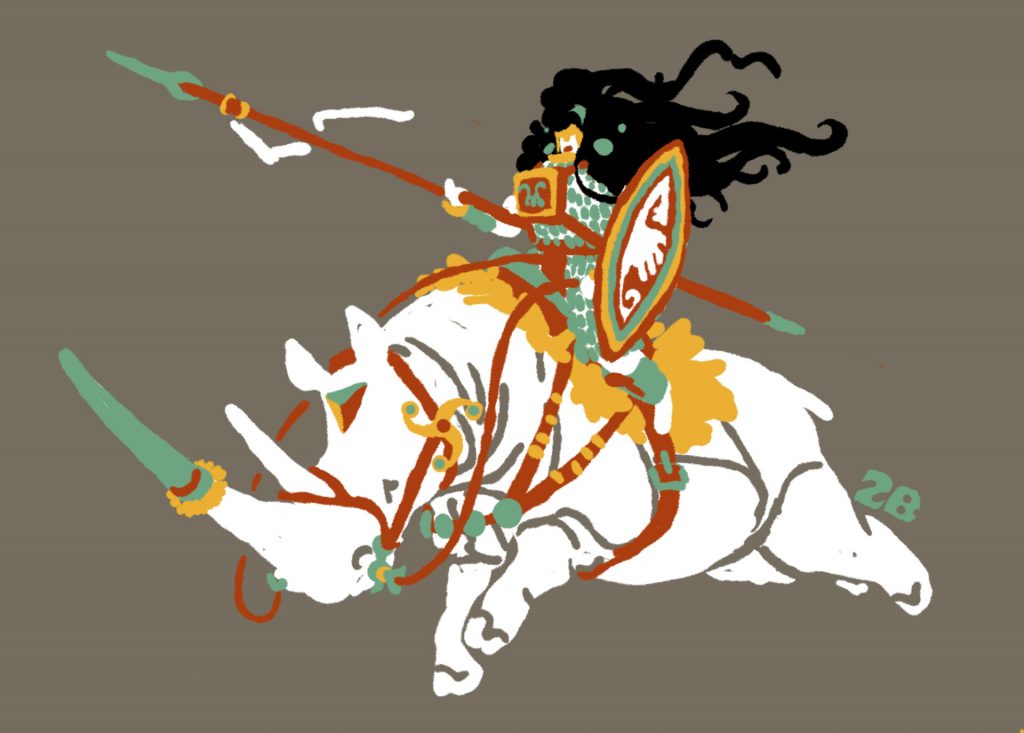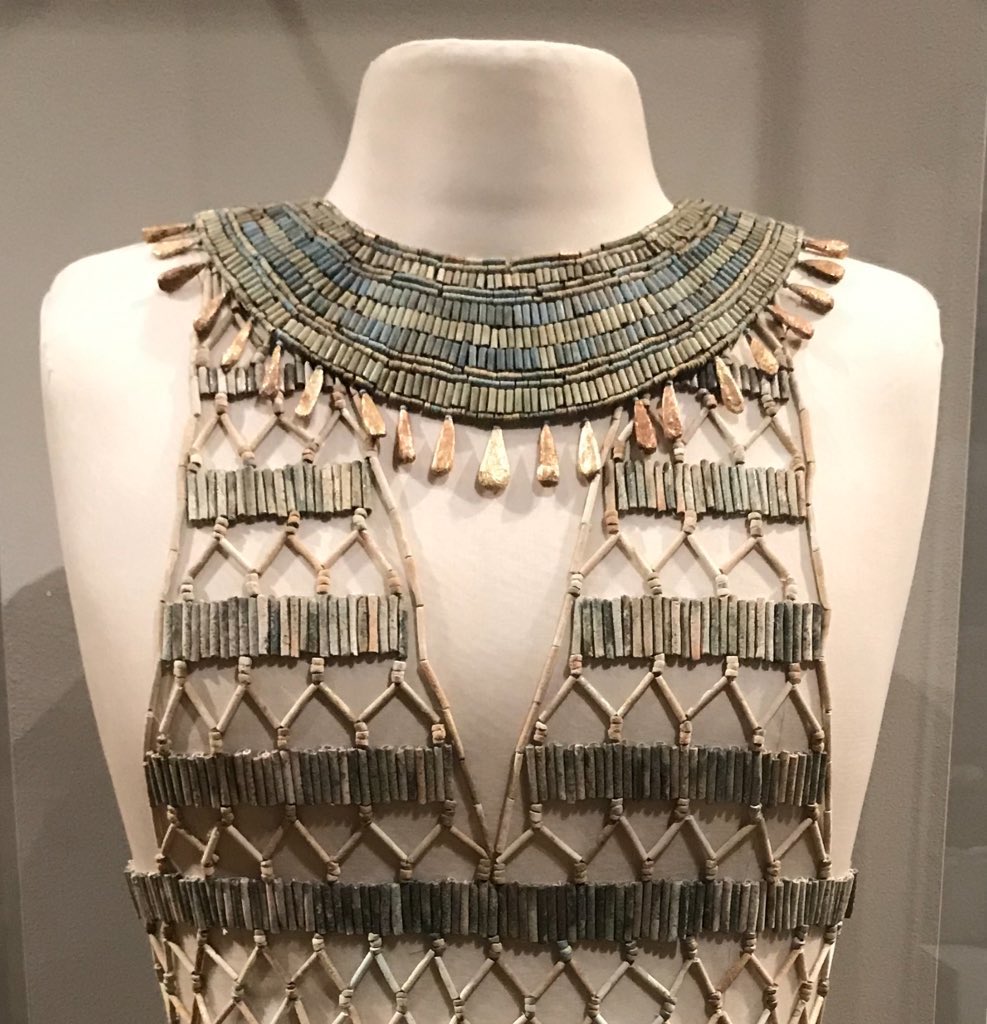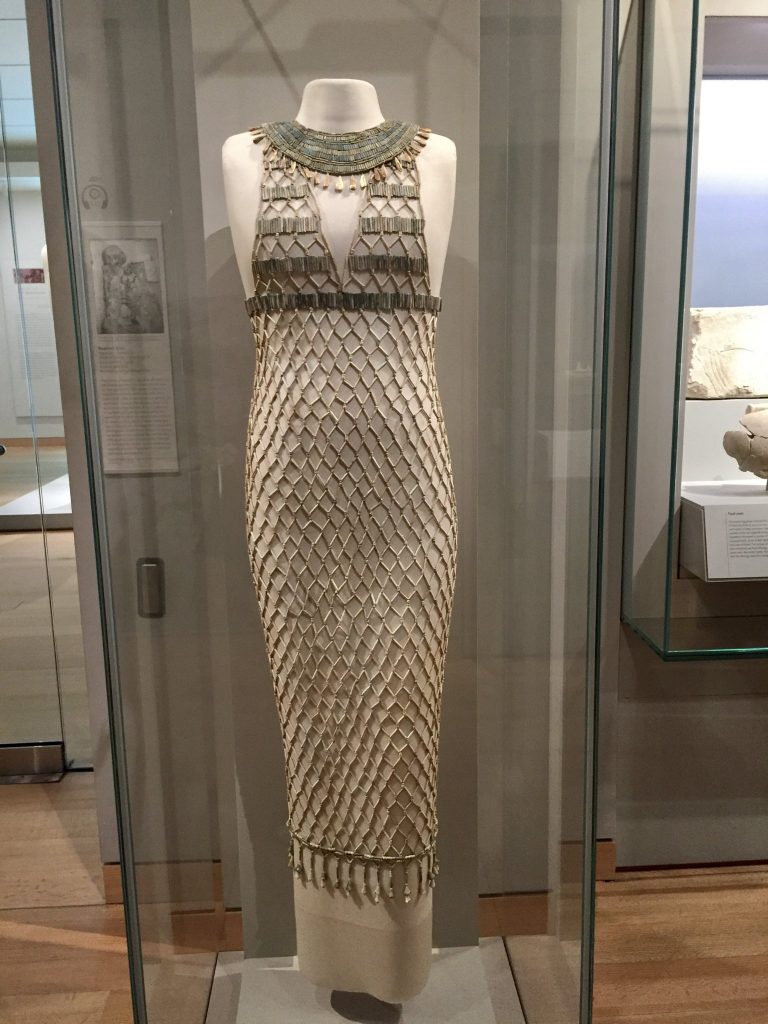Welcome to a new issue of the Journal of Runic Studies, the premier Malkioni publication for studies into the nature of Glorantha. If you haven’t subscribed yet, please consult with the spirit bound to the appropriate electronic page.
God Learner Sorcery
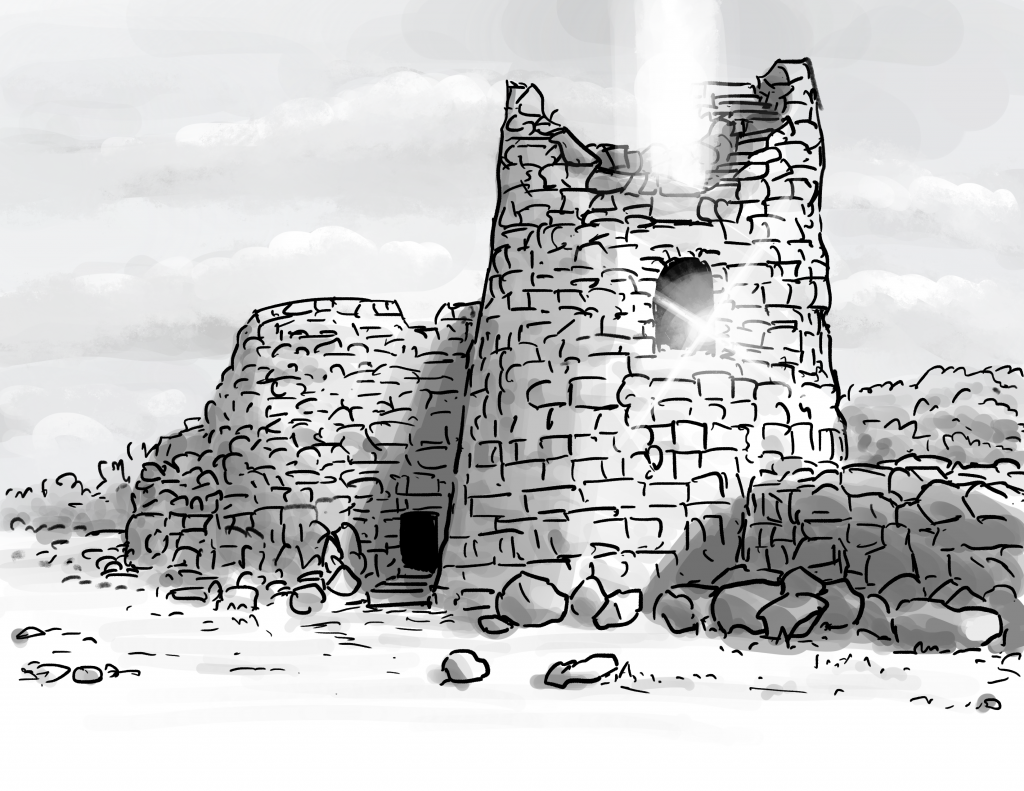
Here is what us God Learners were up to this week.
Episode 8: The Early Days of Glorantha (Part 1)
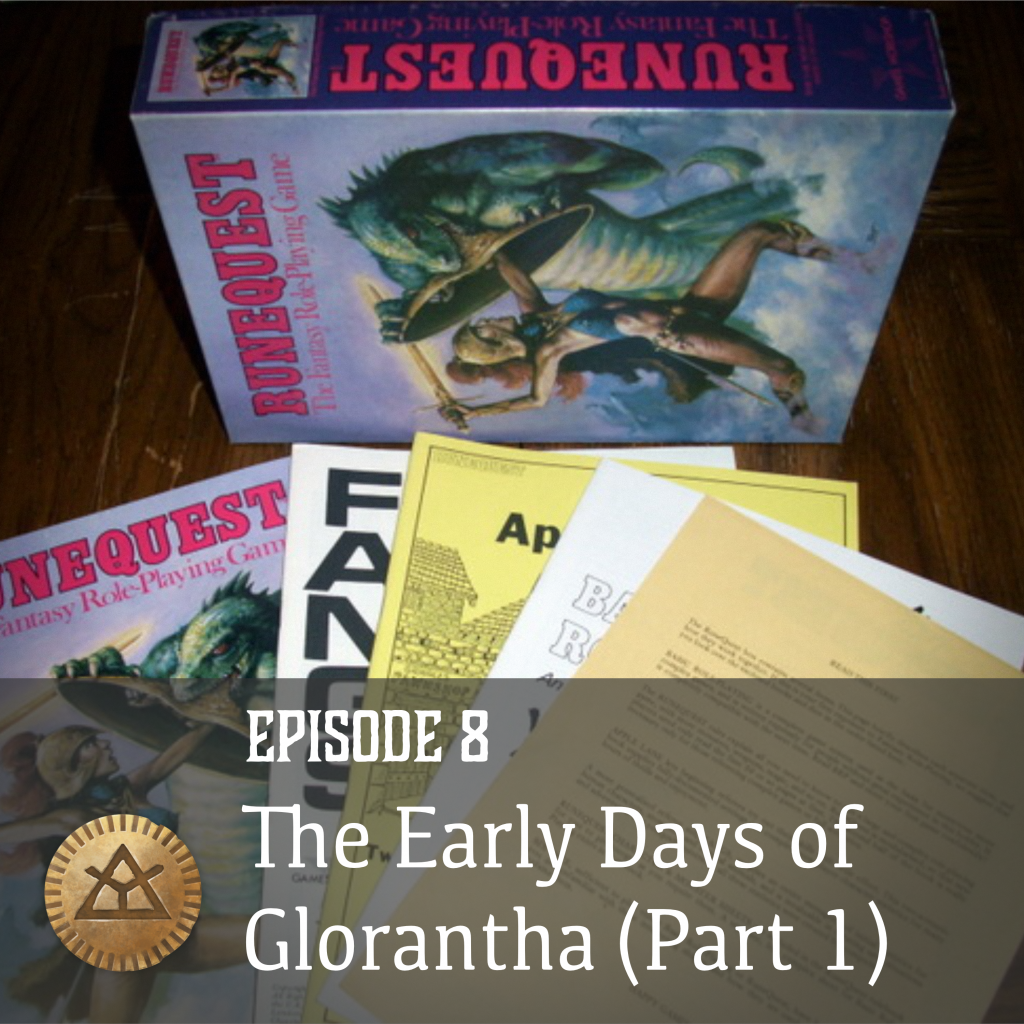
Episode 8 of the podcast is out! We are joined by Andrew “Doc” Cowie, who has more than 40 years of experience with RuneQuest. He talks about what it was like to play RQ2 as a teenager in the UK, how the complicated publishing history of Glorantha affected his gaming, and lot of other tangentially related topics.
A Short Detour is now Copper Best Seller!
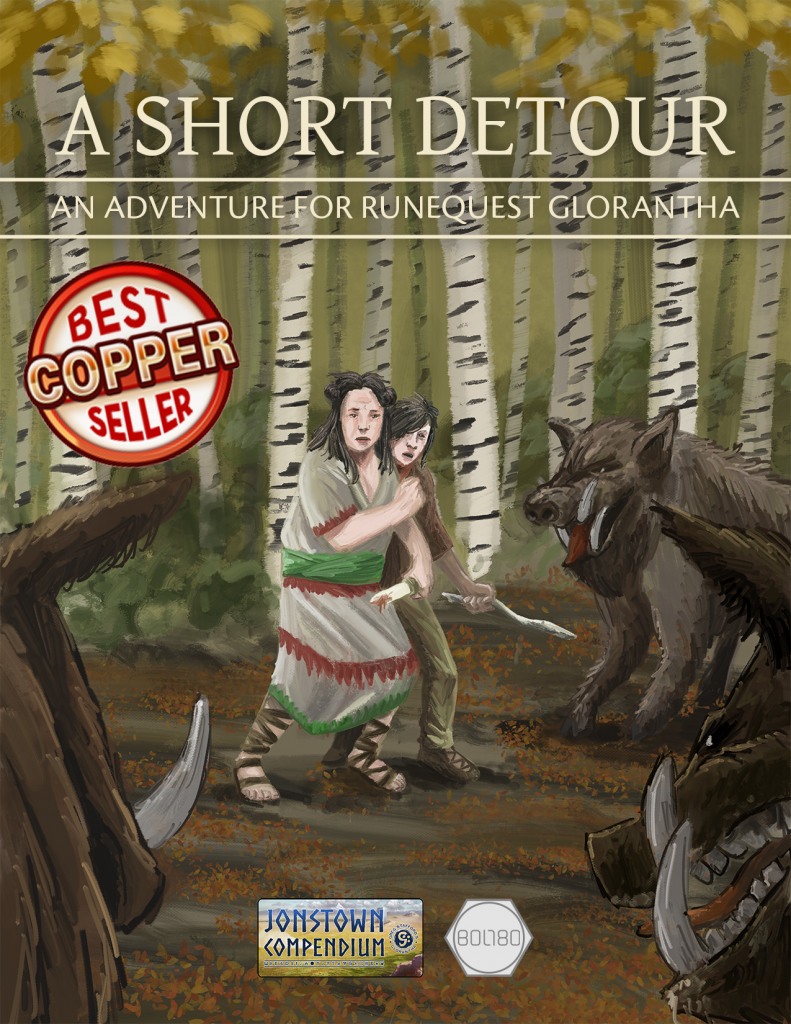
Thanks to all of you who bought the book, left reviews, or sent me private messages via email, Facebook, and Twitter! It’s all very much appreciated!
Chaosium News

Here are this week’s Chaosium news!
A Few Jokes at Glorantha’s Expense
I love the “Out of the Suitcase” articles from Rick Meints, and here’s a new one! It deals with Gloranthan jokes making it onto some of the order forms found in Chaosium products… I won’t spoil the punchlines so go read those (arguably terrible) jokes here!
New Upcoming RuneQuest Actual Play
Chaosium has just started advertising an upcoming Actual Play for RuneQuest… and no, it’s not the return of Jeff Richard’s “White Bull” campaign, but a new campaign with James Coquillat as the gamemaster! And not only that, but a few players from Brian Holland’s recent one-shot (below) are also coming back, such as London Carlisle (playing Varakos), and Cynthia Marie (playing Vasana).
Rounding up the group are Chaosium’s Miskatonic University ambassador Bridget Jeffries (playing Yanioth) and Chaosium’s digital content manager David Naylor (playing Mago).
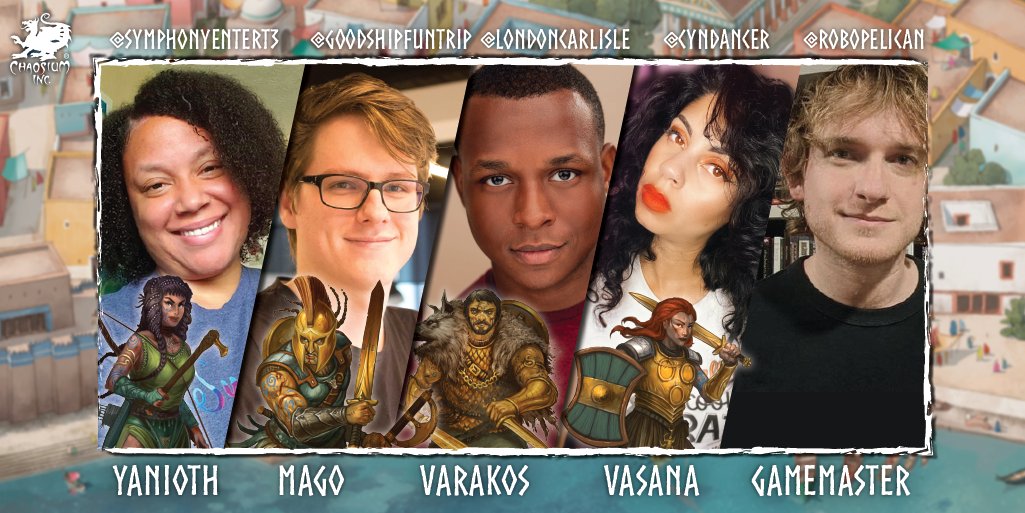
The game will start on Monday, February 14th at 3PM Pacific on Chaosium’s Twitch channel. I’m certain that episodes will later show up on Chaosium’ YouTube channel for those not watching live.
Complementing the RuneQuest Starter Set Dice
If you are looking for getting more of the same dice that came in the Starter Set, Rick Meints shared what they are: Hengda Dice SKU HDP-08.
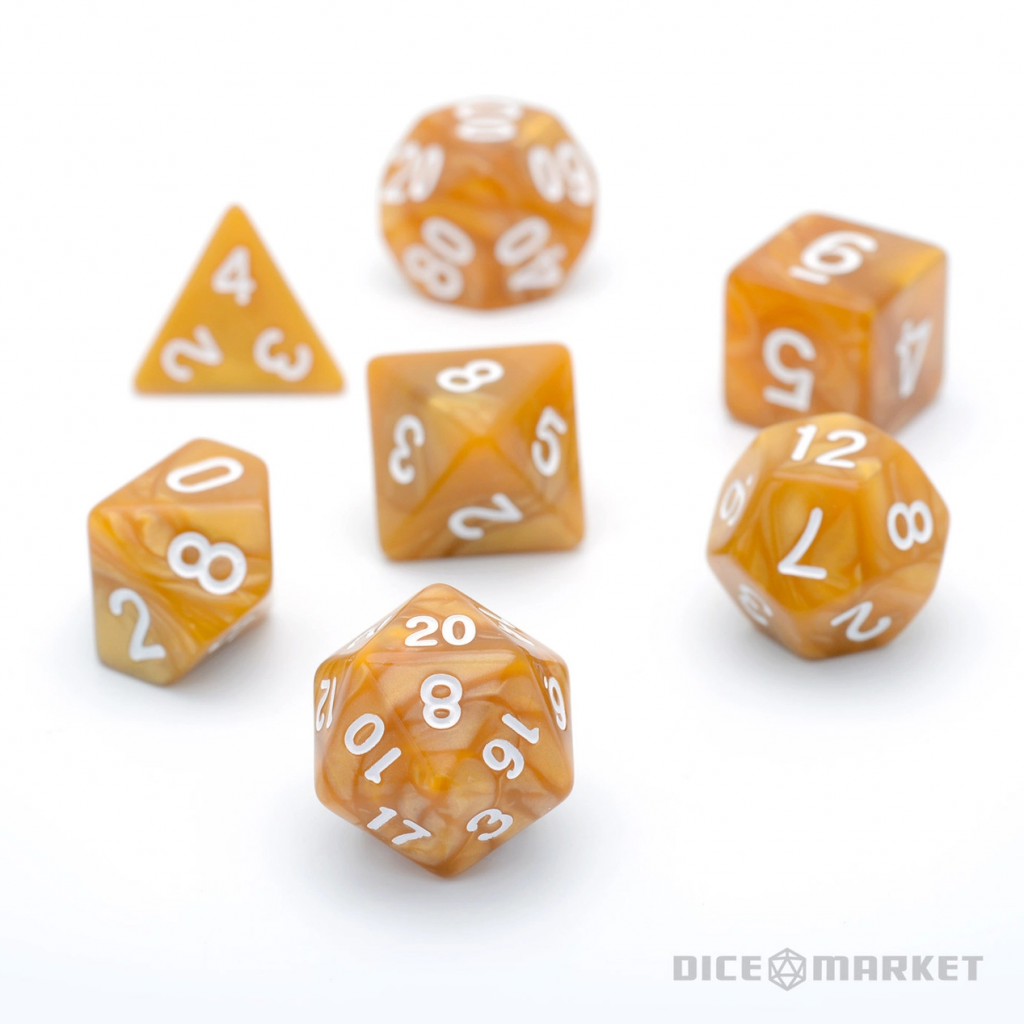
I think that they’re the “Golden Pearl” model pictured above, which you can get here on Dice Market (but you should ask your friendly local gaming store for them).
Giving the Nod
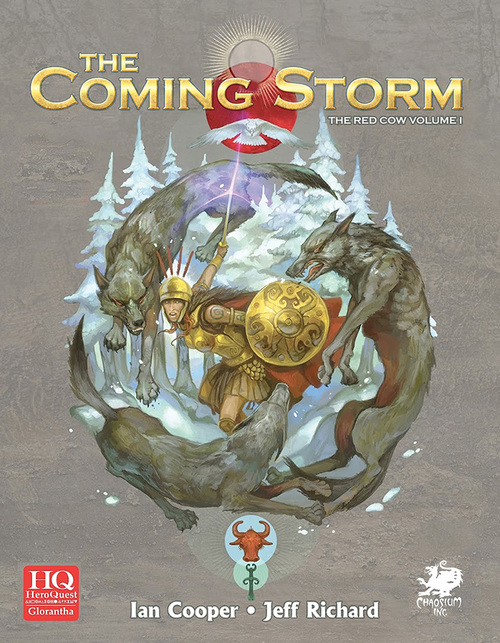
Here is a nice post from Ian Cooper, talking about how much he tried to “give the nod” to fan material when writing The Coming Storm:
We incorporated ideas from material that had been developed in TradeTalk (I tried to at least ‘give the nod’ to much of the fan creativity of the 90s if we could).
Interestingly, I originally wrote Jonstown, from the Sartar Companion, as part of The Coming Storm, with the idea being a campaign that moved from clan to city and back, but we moved it to SC. Again I tried to ‘give the nod’ to that earlier material.
Where Do Morokanths Come From?
Well, obviously, when two Morokanths love each other very much… but no, this is a question on BRP Central about what gave Greg Stafford the idea to make sentient tapir creatures. David Scott posted this page from a book presumably owned by Greg, with the following quote:
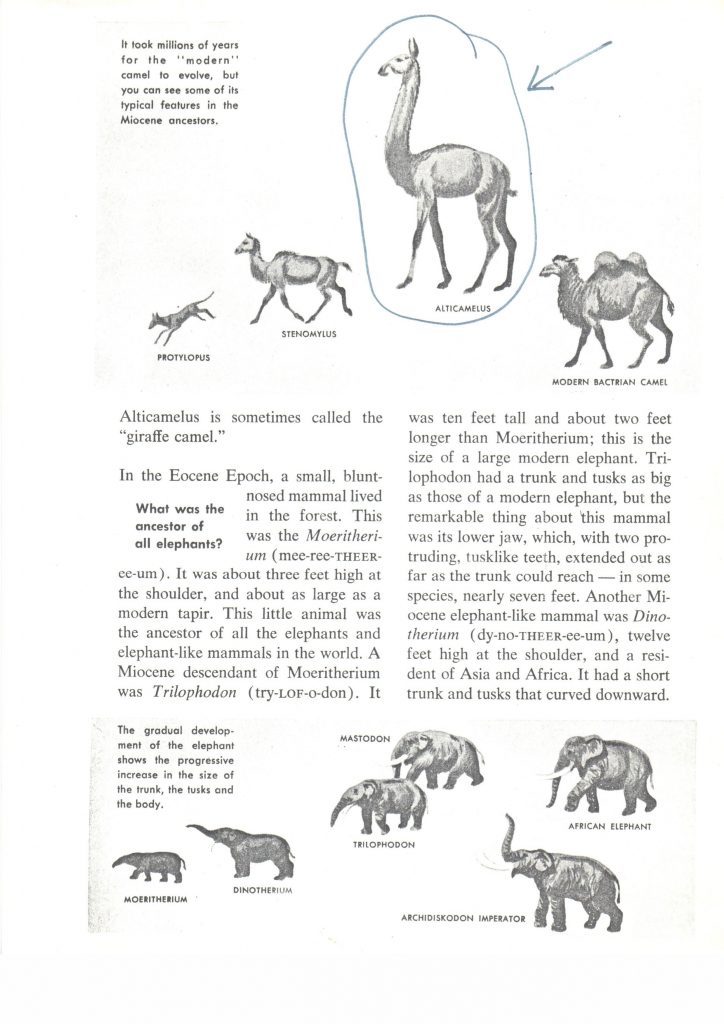
I don’t think it’s a coincidence that the Moeritherium is on the same page (read the entry). I think he was leafing through books to find cool things to use. […]
I also think that Moeritherium is mashed with an -akanth tail from another creature (see chaos-ium)
Swedish RuneQuest News
Joerg is pointing me to this Facebook post which mentions progress on the exclusive campaign book that will accompany the Swedish RuneQuest.
If I am to trust Google Translate, this new material is focused on Skanthi and its capital of Oxhead. This is an Orlanthi region stuck between the Lunar province of Aggar and the Chaos infested Dorastor. Skanthi itself is not quite yet a proper Lunar province, and the Guide mentions a very familiar struggle between the rebellious traditionalists and the pragmatic collaborators. This sounds like a fun way to bring back the “Lunar occupation” gameplay of RQ2’s earlier timeline, while at the same time giving an entirely new spin on things due to the new location.
Anyway, the post says that you will do, among other things:
– Pull out on raids and looting trains. Everything from stealing a few dozen sheep from a neighboring clan to a large-scale raid on the lowlanders in Lakrene.
– Negotiate a marriage with a person from the neighboring clan to strengthen the bonds between the two families.
– Escort the trolls’ winter caravan to the town of Oxhead, where they will sell their exotic goods.
– Participate in the annual Great Hunt, where the country’s foremost hunters are chosen, and where the winner must have laid a magical quarry.
– Sent by the chief to spy in the border areas where the chaos beasts came from during the war, and to investigate whether new attacks are in the trade. One consequence may be that the adventurers get the honor of fighting next to Stormbull’s cultists when Chaos once again threatens to pour in from Dorastor.
– Help the fraternal clans of Aggar rebel against the Moon Empire and fight the brutal General Roan-Ur. At the same time, the adventurers can examine the truth of the rumors that the Moon Empire is preparing an expedition to Aggar (Skanthi’s eastern neighbor) to lay the foundation for a new temple for the Red Goddess cult.
– Fight the ice demons to drive back the winter – for this year.
– Follow a shaman – maybe one of the adventurers? – into the spirit world to annihilate an old curse.
– Make their own social, political, religious and magical careers. An adventurer who starts as a young adult has a whole life ahead of him with unimaginable possibilities! It is even possible to participate in shaping the next age, now that the third age is suffering towards its inevitable end.
Sounds great, but I sadly don’t think the 8 hours of Swedish lessons I once took will be enough to read this…
By the way, Joerg tells me that General Roan-Ur had previously appeared in none other than the Life of Moonson freeform. You can get the new version here.
Jonstown Compendium

The Jonstown Compendium is Chaosium’s community content program for all Gloranthan games, hosted on DriveThruRPG. Disclaimer: all the relevant links are affiliate links that hopefully will let us cover some of the hosting and maintenance costs for the website and podcast! Thanks for using them!
Jonstown Compendium 2022 Index

Nick Brooke has left behind his previous Jonstown Compendium index and made a new one for the new year. And guess what: it currently features my art for A Short Detour on its cover! (although I expect Nick to rotate the art with every major update to the index)
These index….es? Indices? Err…. these compilations are useful for gamemasters looking for the best Jonston Compendium book to buy and fit into their ongoing campaign.
Jeff’s Notes

Jeff Richard, the current mastermind on everything Gloranthan at Chaosium, is often posting notes and thoughts on the RuneQuest Facebook group. Here’s our curated list from the past week. A partial archive of these sources is compiled on the Well of Daliath.
Belintar
Jeff talks about Belintar, the mysterious heroquester and founder of the Holy Country:
We all know about Belintar’s first incarnation – from when he appeared off the shore of Kethaela in 1313 and his titanic struggle with the Only Old One that resulted in his apotheosis as the God-King of the Holy Country. We also all know that Belintar’s mortal shell expired many times, and that the Tournament of the Masters of Luck and Death was a great magical-mythical contest that selected the new incarnation of Belintar and kept the Divine Realm in close proximity to the Holy Country.
The Only Old One was some kind of half-troll (or something), the son of Argan Argar (the troll God of Surface Darkness) and Esrola (an Earth goddess). As far as I understand, Belintar sort of cheated: he was killed by the Only Old One, but came back the next year to try again, succeeding.
The “Divine Realm” mentioned here is, I think, the Holy Country version of the Proximate Holy Realm, which was mentioned in issue #30. Basically, the mythical design of the Holy Country, and the regular Tournament of the Masters of Luck and Death (MOLAD), maintained some kind of magical field over the whole place, which made it easier to… do stuff. But, like, cool stuff.
Belintar had a cult and many priests in each of the Sixths who offered him magic points, incense, and other accoutrements of worship. This worship aided him in doing many miracles, such as extending the Magical Roads that connected the Sixths to the City of Wonders or indeed in maintaining the City of Wonders itself.
The City of Wonders was in the centre of this magical mythical Disneyland we call the Holy Country. The “Sixths” were each of the themed lands of the metaphorical amusement park. Clockwise from the south, the Sixths were the Rightarm Islands (Water), Caladraland (Fire), Esrolia (Earth), the Shadow Plateau (Darkness), Heortland (Air), and, God Forgot (Joerg tells me it might stand for the Man Rune, but also points out that Prince of Sartar hinted more simply towards the last elemental Rune, aka the Moon Rune… but maybe to represent spirituality rather than the present Red Moon).

The prime function of each incarnation of Belintar was to maintain the proximity of the divine realm with the Holy Country. In some ways, Belintar can be thought of as a high priest of each of the gods whose job was to communicate between the gods and their worshipers AND between the gods and themselves. He reconciled the needs of the gods and their many different cults.
Now Belintar was rarely powerful enough to impose his will on the gods. Instead, he needed to work with the gods, and often interacted with them in the divine realm for the benefit of the people of the Holy Country. This involved near constant heroquesting. Like the time Belintar brought the Jolly Fat Man to Nochet so he might reside within the city. Or the time Belintar brought Heort to Stormwalk Mountain so they could both view the Holy Country. Or when Belintar got Argan Argar to invite him to share a meal with the Mistress Race Trolls beneath the Tarpit.
Each incarnation, regardless of their mortal identity, always appeared as Belintar in the Hero Plane. The gods recognized him regardless of incarnation and the many pacts and bargains he made were always upheld by the gods. Because of the proximity of the divine realm with the Holy Country, gods often manifested in the Holy Country, visiting their worshipers even outside of the worship ceremonies!
Belintar rarely got directly involved in governing the mundane affairs of the peoples of the Holy Country. Each of the Sixths more or less followed their traditional ways – of course those traditions were changed by the very presence and role of Belintar. When a cult’s leaders might refuse to accept Belintar or reject his advice, Belintar was known to bring the cult’s own god into the discussion! But Belintar’s demands were few and always reasonable, and it was usually quite easy for cults and tribes to accept what he had to say.
We’ve already read Jeff mention it before, but a lot of the important people in modern Sartar gained heroquesting experience in the Holy Country, especially while Lunars occupied their lands:
Belintar and the Tournament of the Masters of Luck of Death served as a heroquesting school for the Sartarites. Heroquesting techniques that were lost or rejected by most cultures were developed and refined in the Holy Country.
If you read older material, you might see Belintar referred to as “pharaoh”, but that term is now abandoned because it obviously gave the wrong idea. Similarly, don’t imagine Belintar’s Holy Country as a well organized machine (which is probably where the comparison with Disneyland falls down). It sounds more like some underground artist venue:
What never really developed around Belintar was the sort of court administration as you see in Glamour. Belintar surrounded himself with philosophers, mystics, magical individuals, adventurers, and vacationing gods. When young Tarkalor visited the City of Wonders, he met:
– Belintar, who was a woman at the time
– Enamyx, the “False Daughter” of Belintar (she was the daughter of a previous incarnation)
– Darkasten, Prince of the Hendriki
– Antagorn, the Rich Thief of Nochet
– Bardranu, the Teshnite nobleman
– Mister Bondaru, the philosopher
– The Tanist, Belintar’s identical stand-inAs well as such strange beings as the Dwarf Giant, the Spirit of Freedom, The Constant Guard, The Five Physical Spirits, The Reef Master, and the Tide Lord.
I’m getting Andy Warhol & The Velvet Underground vibes here.
Anyway, the Lunar Empire wanted access to the sea, and to the trade that comes from it. As a point of reference, Jeff mentioned in passing that the Kingdom Sartar was richer than most Lunar provinces thanks to this trade… so they got Jar-eel ( the bad-ass Xena Warrior Princess daughter of the Red Emperor) to remove the only thing that stood in the way:
But now Belintar is gone. No heroquest is going to bring those tattered webs back into place, or rebuild Humpty Dumpty’s broken egg. Jar-eel tore it into parts, shattered the pillars, and broke the Tournament of the Masters of Luck and Death so that it always fails. That magic is still churning and looking for an outlet, but can’t find one. The divine realm is still in proximity with the mundane world and is now easy to grab. And that goes a long way to understanding the Hero Wars.
As I understand this, because there’s so much magic hanging around, instead of a “normal” war between the Lunars and everybody else, it’s now a war between gods and heroes and spirits too. The Third Age was due for a reboot anyway.
Later, Jeff talks about Belintar’s effect on the neighbours:
Increasingly I view Belintar as the mentor or godfather of the Sartar Dynasty and later the Sartar Magical Union. He is a big reason why the Orlanthi of Sartar really don’t resemble the Orlanthi of King of Dragon Pass or Thunder Rebels.
It sounds like after looking at Sartar in relation with everything around it (Peloria, Prax, the Holy Country), Jeff realized that it would be better to emphasize the trade and heroquesting aspects that the Kingdom gets from its neighbours. That makes it a lot less about “isolated hillbillies” and a lot more about “proud tax-taking hosts and
And Belintar was there for centuries. Not really a single individual, not really an office, but definitely a single soul that had many incarnations.
That’s the hardest thing to get around – that Belintar had many incarnations, each with their own personalities and appearances, but the same powerful soul. And each incarnation knew secrets that only Belintar could know.
Who is the other big guy with multiple incarnations again? Oh, right, Moonson, the Red Emperor:
Moonson is certainly similar. But if you dig you find some big differences. Moonson was created by the Red Goddess to manage her worldly affairs after she rose into the sky as the Red Moon. Belintar made himself through contests, pacts, and proofs that he made throughout the Holy Country and now must make anew roughly every generation through the Tournament of the Masters of Luck and Death.
And remember, every incarnation of Belintar has managed to succeed in the Tournament of the Masters of Luck and Death, which is a far more “experimental heroquest” than the Ten Tests of a Dara Happan Emperor (and much harder to rig in your favour). Politics plays much smaller role in selecting the new incarnation of Belintar (usually none at all) than it does in selecting a new Mask.
The “Ten Tests” are a bunch of magical challenges meant to prove that you can be the rightful Emperor of Dara Happa. By now, I’m not sure if the Red Emperor needs to do them anymore, but historically several Red Emperors completed them to prove their rule over the former Dara Happan lands that make up a good chunk of the Lunar Heartlands.
Anyway, we have a guy who has a “mortal element” that he swaps with a new one when the previous one dies, and an “immortal element” that carries on, like some Methuselah from Altered Carbon. Who else does that in Glorantha besides the Red Emperor?
[…] there’s probably a dozen or more entities in Glorantha that do that.
Just off the top of the head – Mani, Jaldon Goldentooth, the Founder Khans, Aronius Jaranthir, the Only Old One, possibly Waha, and Arkat.
Oh boy, I don’t know half of these names… time to look into some PDFs!
- Mani is the guy who gives his name to Mani’s Fort in the Big Rubble in Prax. He’s known as Mani Tor or Mani of the Many Lives. He reincarnates into his tribe (the well named Mani tribe) every two or three generations.
- Jaldon Goldentooth was a Khan of the Bison tribe who kicked the Pure Horse People out of Prax (they went to the Grazelands), sacked Pavis a few times, fought the Empire of the Wyrms Friends, and is generally considered as a hero of all Praxian tribes, having united them against a common enemy during his lifetime. He has been “summoned” a few times since, whenever the Praxian tribes needed unified again, including by Argrath during the upcoming Hero Wars. Several of his bodies lay at Jaldon’s Rest, which you can find in a Dragon Pass map somewhere between Dangerford and Moonbroth.
- I had no idea who the “Founder Khans” were until Joerg pointed me to Nomad Gods (whose rules booklet is available in PDF here). Without much surprise, they are the original founders of each of the Praxian tribes. In the Nomad Gods board game, a current tribal Khan can “call” upon their Founder and make them appear on the board.
- Aronius Jaranthir is a Carmanian hero who helped the Red Emperor twice, more than a century apart, having died in between.
- We already mentioned the Only Old One, the sort-of-troll who ruled the Shadow Plateau.
- Waha is one of the cults in the RuneQuest rulebook so we know who that is, but it’s indeed worth mentioning that he seems to show up occasionally in history. I’ve got no idea how that happens though… he seems to just be there.
- Arkat is the big scary guy who fought Nysalor’s Empire of Light and ended the Second Age. He was killed a few times, but that didn’t stick. It seems more like self-resurrection, or enough bad-assery to walk out of the Underworld, rather than some reincarnation shtick like Belintar, but what do I know.
I think that King Ironhoof might qualify too — he’s the leader of all the Beast People of Beast Valley, and every now and then (when needed) he reincarnates into the current Centaur King’s body.
What does it take to be the next Belintar?
I think we modern Westerners tend to have a very ego-centric sense of the self. Think of Belintar as a hero out of some young adult fantasy series. Belintar is dead, so now we have a big contest and tournament to choose the new Belintar. During this contest, our hero succeeds in making the pacts and winning the contests that are necessary to magical unify the six lands, including displaying the necessary temperament and self-discipline to serve as Belintar, and in the process starts to communicate with all the previous Belintars. Many Who Are One. In the end, our hero triumphs and becomes the new Belintar, aided by all those who came before.
And our new Belintar is capable of calling upon all their prior selfs. But is also their own self. And all share in that mighty soul called Belintar, which is recognized by the gods and spirits of the Holy Country.
Jeff offers Avatar as the closest pop culture reference for Belintar. And he means the excellent “Avatar: The Last Airbender” animated series, here… not the James Cameron action movie with giant blue people. By the way, if you’ve been living under a rock and don’t know about the immensely popular crowdfunding campaign for the Avatar RPG, learn more here from Magpie Games.
The Only Old One’s Return
There were a lot of interesting comments on the previous item, so I’m taking some of them into their own item:
The Only Old One had endured for over a thousand years. He was the offspring of Argan Argar and Esrola, but also at some means a mortal or demigod rather than a full god subject to the constraints of the Compromise. He regularly acted in Time, but is thought to have had several incarnations. He definitely did not require something like the Tournament – instead it would appear that his connection to the divine realm was his Palace of Black Glass that enabled him to directly access the Underworld.
He was destroyed by Belintar, but it might not be the last we hear about him:
There are rumours that the Argan Argar cult seeks to reassemble [the Only Old One’s] pieces so that he may return to the world, but nobody other than the Argan Argar cult thinks that would be a good idea. There isn’t exactly a lot of nostalgia for the OOO in the Holy Country, outside of Argan Argar and the trolls.
Belintar was fair with the trolls and took no action against them despite his war with the OOO. The trolls participated in the Tournament and even won on at least one occasion. But now that Belintar is gone, I wouldn’t be surprised if there are some trolls searching through the Underworld for a way to find the OOO.
The Red Emperor’s Titles
And here’s another comment from the Belintar thread that I think is worth reading:
Remember that the Lunar Empire is not truly a “state”. It is dynasty appointed by the Red Goddess to manage her worldly affairs. The head of that dynasty holds several “state titles” like Emperor of Dara Happa and Shah of Carmania, etc., but in the end his rule rests on things like:
1. His position as the head of the Lunar Religion
2. His ability to command the Yelmite nobility
3. His personal power
4. His ability to give out gifts to powerful supporters, soldiers, and magicians.
5. His command of the Crimson Bat
6. His ability to keep other powerful individuals and groups satisfied.
7. His ability to maintain his system of satraps and client kings.And so on. The Red Emperor has tremendous power but in none of these categories is it unquestioned. For example, his position as the head of the Lunar Religion requires accommodating Great Sister and Jar-eel. His ability to command the Yelmite nobility means doing Yelmite things. And so on.
I had never heard of Great Sister before so I assume some of you might need this: apparently she’s a demigoddess daughter of the Red Moon, and as such she answers directly to her, and not the Red Emperor. She controls an independent military unit (the “Sister’s Army”), and reincarnates every now and then — although her current incarnation is more than a century old.
Argrath’s Life (up to 1627)
Here is Jeff’s “short” summary:
So the basic story is that Argrath was exiled to Prax as a youth. He was taken as a slave by the Bison Tribe, but while a slave he found/freed the White Bull spirit. The White Bull is a son of Storm Bull/brother of Waha who the Praxians believe will lead them to fight a final battle against Gbaji or Chaos or whatever.
Argrath, as the person in direct contact with the White Bull, becomes the leader of this new magical society, which thanks to the Lunars spreads quickly within all the Praxian tribes.
But meanwhile, Argrath is part of the Sartar Dynasty (from a minor branch, but thanks to the Lunars that’s really all there is) and is an Orlanth Adventurous cultist. He is an experimental heroquester (where do you think he found the White Bull?) and is seeking things in the weird recesses of the Hero Plane – the Drinking Giant’s Cauldron, the Dragonteeth, etc. When a baby giant is born as an unexpected side effect of one of these quests, Argrath protects her on her voyage to the sea. This brings him into contact with Harrek the Berserk.
The Lunar ran an assassination campaign against all heirs to the Sartar throne in the early 1600s, which is something you can see in the RuneQuest Glorantha character creation, during the family history step. So that’s why Argrath is “viable” as a Prince even though he’s like a grandson of a cousin of something.
It’s interesting however that he’s an experimental heroquester from the beginning of his “career”… as far as I know, he went pretty quickly from his adulthood initiation to being exiled to Prax, so he’s doing all this on instinct, as a prodigy. It’s probably only later that he goes to the Holy Country and gets even more experience heroquesting.
It’s also interesting that the giant’s cradle, which is such a big element of the old RuneQuest Praxian campaigns, is directly linked to Argrath’s heroquesting.
After a rocky start, Harrek and Argrath become allies and they circumnavigate around the Homeward Ocean, plundering and adventuring, and seeing all sorts of things. Teshnite sun priests, Teleosites, bat-hsunchen in Laskal, Doraddi, Fonritian Ompalam cultists, the ruins of Jrustela, Seshengi sorcerers, and so much more. By the time Argrath gets to the Holy Country, he is one of the most broadly adventured people in Glorantha.
From the Holy Country, Argrath returns to Prax where the White Bull movement has spread during his absence. He gathers members from all the tribes and summons Jaldon Goldentooth so that he can conquer (liberate) New Pavis from the Lunars. After that he quickly unrolls the Lunar garrisons in the River of Cradles.
Shortly after, he gets his first major set-back. Argrath tries to conquer Dragon Pass with his Praxian allies, but is beaten by the Lunar College of Magic at Hender’s Ruins. He returns to New Pavis to recoup, but in the meanwhile the Dragonrise happens and Kallyr Starbrow is acclaimed Prince of Sartar.
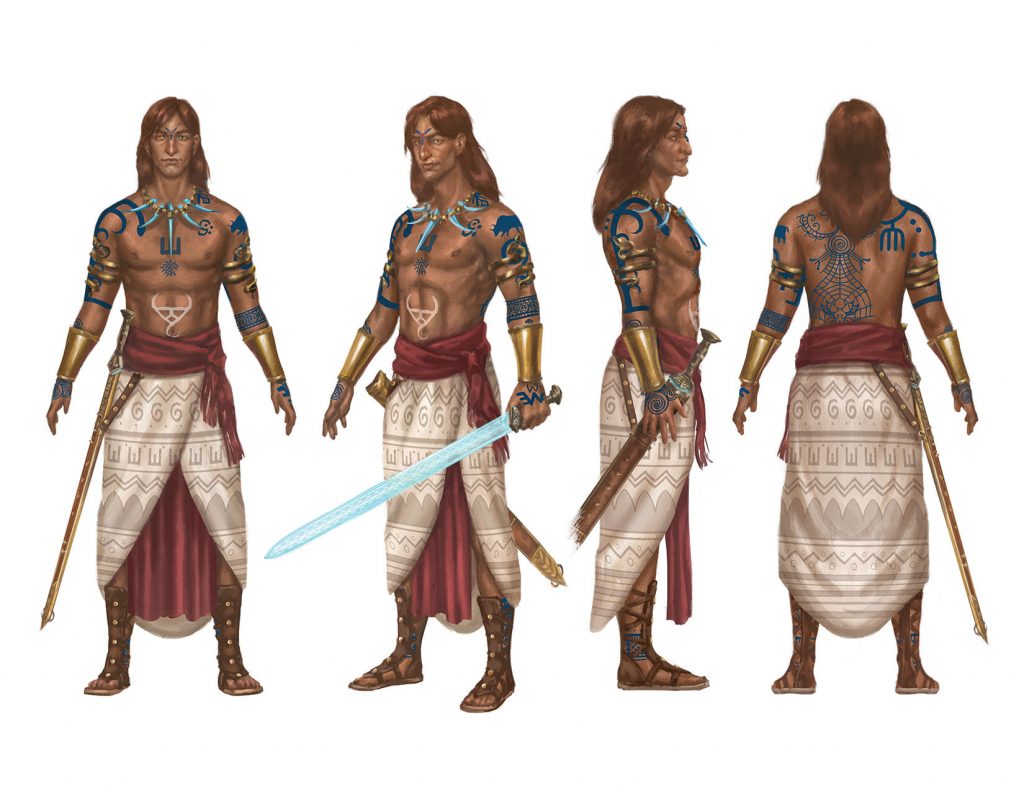
This brings us to 1625, the starting date of RuneQuest Glorantha.
Kallyr’s rule of Sartar is short-lived and Argrath returns to Dragon Pass with an army of Praxians and adventurers. After forcing the Lunars out of Alda-Chur, Argrath marches on Boldhome and is acclaimed Prince of Sartar. He has little direct relationship with the traditional Sartarite leaders – the tribes and the city councils, but he is backed by Orlanth Adventurous, Storm Bull, tricksters, an army of Praxians, plenty of misfits, adventurers, outlaws, hedge priests, shamans, and weirdos – basically everything that Thunder Rebels says isn’t there.
Its clear that the new Prince with a seasoned army (and plenty of cavalry) plans to strike against the Lunar Empire, but first he needs to get his ducks in a row, so to speak. But the clock is ticking as the Red Emperor and Jar-eel have suppressed the revolt in the Redlands, and are restoring order to the Lunar Provinces.
That’s the scene in 1627 when the ball really starts rolling. At that point we are in the White Bear and Red Moon board game.
I’ve heard before of the “Multiple Argraths” theory, which stipulates that all the deeds attributed to “Argrath” were actually done by multiple people, because obviously one guy can’t have done all these things. Even the Glorantha Wiki (at the time of writing) embraces it completely with their article on Argrath. But that theory is officially non-official:
Greg and I both concluded that the “multiple Argraths” turned out to be a failure and an obstacle for gamesters. And a nightmare if we ever want to do RQ fiction. You’ll see that we abandoned that approach in the Guide to Glorantha, Glorantha Sourcebook, and everything since.
Like any major historical figure, he has many contradictory stories about him. For example, a story might put in him in Nochet at the same time he is supposed to be in Pavis or tomb raiding in Jrustela. That’s totally fine – and the same thing is true of Jar-eel, Harrek, Arkat, etc.
Lunar Point of View
Jeff commented on this question on Facebook with his take on the average Lunar’s opinion of the Empire:
In character: because I grew up in Furthest or Jillaro or Yuthuppa or wherever. I am a citizen of city X and a loyal person of our Red Emperor, the Moonson and the ruler of the world. The Red Goddess is our patron and she remade the world in our benefit.
Look into the sky! There She is – the Red Moon. She blesses us with Her very presence. She tasked Her son with ruling the mundane world and protecting Her people.
Many enjoy Her blessings but do not know Her secrets. However, I was initiated into the Seven Mothers as a young adult, just as my parents were before me. I have felt the desperate need that drove the Seven Mothers to find *something* that could remake the world and save them – that *something* is none other than the Red Goddess.
This was followed by some extra notes:
I think the overwhelming majority of Lunars justify being a Lunar in some manner like the above. To be outside of the empire is to be a barbarian, a rebel, a monster. The Red Goddess is the patron of the empire and her son is its ruler.
If I wanted to be outside of the empire and justify it, it is easiest to point to the millions of Pelorians who have enjoyed peace and prosperity over the last century and a half. Most Lunars have not seen or experienced war or privation in their lifetime or that of their parents or that of their grandparents or that of their great-grandparents or…
I personally think very few – if any – Lunars justify their religion or empire by referencing the Orlanthi or Pentans or who ever – the year is 1625 not 1275 after all! The Lunar Empire is its own justification, as is the Red Moon in the sky. It is there, we benefit from it, and have benefited from it for as many generations as we can recall. The Red Goddess has proven herself, and for countless generations, her initiates and religion have blessed us. It is simply who we are now.
Similarly, the conflict between the Lunar Empire and the barbarians/rebels/monsters outside of it is taken for granted by most people. The Lunar Empire has all sorts of ceremonies that define the world and if you are a Lunar, you are on the inside. The Orlanthi, Praxians, Pentans, trolls, dwarfs, elves, dragonewts, etc. are by definition on the outside.
Most Lunars fear Chaos in the same way that they fear Death, although perhaps even more viscerally. Everyone knows that the Crimson Bat is a terrible monster, but one that serves the Red Goddess (and more immediately, the Red Emperor). Everyone knows that broo, ogres, and other monsters are evil, but they can serve the Red Emperor if they submit to him and obey his commands (like do not kill my people). Philosophers and mystics may raise questions about the Compromise, but the Red Goddess overcame the limitations of the Old Gods and proved her power at the Battle of Castle Blue, so why are you going on about that?
Another thing is to think of the Lunar Religion as a series of mystery cults placed inside of each other. We start with the Seven Mothers or their equivalent (Hon-eel, Hwarin Dalthippa, etc). That’s about as deep as most Lunars ever go. It celebrates the birth (and life) of the Red Goddess, and embraces both Life and Death – but is not Chaotic.
Let me repeat that for emphasis – the Seven Mothers are NOT Chaotic.
But the Seven Mothers grounds us for the next level. See chief priestesses CAN Bless folk with Chaos through the Red Goddess. Sparingly, and the Chaos Blessing is temporary. Priestesses learn more, experience more, and can study the Nysalorean Riddles.
And once Illuminated, a priestess can go much deeper and learn the mysteries of the Red Goddess. They can learn to warp the Spirit World. And they can learn to call upon Primal Chaos. Because the Red Goddess embraces both Life and CHAOS – a deeper understanding than what the Seven Mothers can provide. At that point we are ready to explore like the Red Goddess herself did.
But this final group is a tiny percentage of the Lunar population. There are probably fewer than 10,000 Red Goddess initiates in the entire Lunar Empire. Probably half of them are in Glamour. The next big batch is the Lunar College of Magic, key officials in the satrapies and provinces, etc. The ruling elite.
The Winter Deities
Looks like it’s snowing in Colorado, so Jeff is thinking about winter:
It is the right time of year (at least in Colorado) to talk about the trinity of winter deities – Valind, Inora, and Himile. These gods are much more important than their tiny cults would suggest.
Valind is the Winter King. He is a dangerous and powerful god who brings the winter storms, snow, and ice across Genertela. In the Lesser Darkness he ruled much of the world, and his glacier – a vast accumulation of ice and snow – displayed his might. Each winter, he advances from his glacier stronghold and tries to conquer Genertela. He is initially aided and later opposed by his storm god kinsfolk, but he always is eventually forced back so that spring can occur.
In recent decades, the Lunars send an annual group of heroquesters to fight him on the glacier and force him back, as the ancient hero Kallikos did before Time. This has weakened his advances into Peloria, and shortened winter. But Valind himself remains powerful and has built up resentment against Peloria like a river against a dam. Now if the Lunar heroquesters ever fail, winter will return with a terrible vengeance.
I wonder who’s going to make these heroquesters fail? Mmmmh…
Inora is the goddess of the snows, particularly the mountain snows that remain year round. In some lands she is viewed as an enemy; in others she is the primary source of water and fertility. She is the half-sister of Orlanth and an ally of Valind.
Huh, I didn’t know about Inora before (although I think I came across her name once or twice). I guess I should mention her in my Alone Confederation campaign, since the Indigo Mountains have a few glaciers… although Skyfall Lake and Engizi might be more important for bringing water and fertility to the valley in this particular location.
Himile is the god of cold itself, a dark and hungry god, even more terrible at night than day. He is perhaps the most dangerous of the three gods of winter, but the least obvious.
That’s interesting… Himile is related to the Darkness pantheon, and is said to be worshipped in “cold places”. Trolls in Pent have a sizable worship of him, for instance. I’m getting Wendigo vibes here. Which is a good thing.
Safelster
Here is a region of Genertela I don’t know about, even though I’ve seen it mentioned many times!
Safelster is a fascinating area, both familiar and very different. Some 2.9 million people are within 100 km of Lake Felster, which itself is about 200 km long. The area is densely populated, with an overall average density of 21 per square km. However, it gets closer to 80 per sq. km near the lake and lower the further away you go.
Let’s put this on the AAA maps. Lake Felster is west of the Mislari Mountains, and northwest of Maniria. It’s two-thirds of the way from the Holy Country to the west coast.
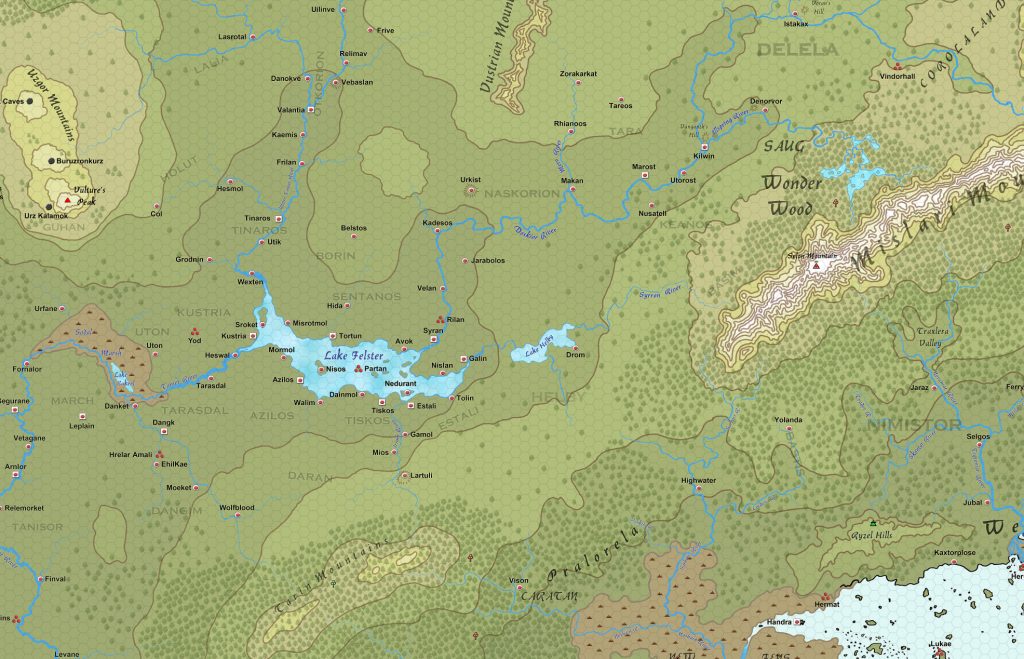
There’s also a lot of people living there: about 3 million humans according to the Guide. Compare that to the mere 655,000 humans in Dragon Pass…
Lake Felster is somewhat smaller than Lake Ontario, just to get a feel for it.
Which means it’s big enough that when you’re standing on the shore, you can barely see the other side, and on most days, it’s like standing next to the sea.
Rokari, Orlanthi, Old Gods, Stygians, and numerous other Malkioni sects and heresies all can be found here. There are trolls and elves, but few dwarfs. The Lunar Empire is nowhere to be seen, but an ascendent Kingdom of Seshnela aspires to hegemonic power.
Malkioni sects are basically different schools of thought for western sorcerers, and each often comes with a different focus. So just like RuneQuest cults are more than character classes because they come with a culture, traditions, specific world-views, and so on, Malkioni sects are also a bit more than just “Fire College of Magic” or whatever.
- The Rokari school are, as far as I can tell, the “die hard” Malkioni people who follow the Abiding Book to the letter, and put everybody in castes for life (noble, wizard, soldier, farmer), as opposed to, say, the Hrestoli who encourage caste mobility so that a small elite becomes “Men-of-All” (i.e. people who can do everything).
- By Orlanthi, I think that Jeff here means some sort of henotheist school where they consider the Invisible God to be the supreme divine entity, but still acknowledge and worship whatever “lesser” gods (in this case, Orlanthi) is appropriate for the area?
- Stygianism is the Malkioni school that holds Darkness as the source of everything, and that everything will eventually go back to Darkness. Possibly related to Arkat (he’s a big deal around here), but regardless, this is your ticket if you want to do cool Dakrness sorcery.
The Kingdom of Seshnela used to be to the southwest of Lake Felster, but it was destroyed in the Second Age, literally: their peninsula was shattered and only islands and ruins were left behind. The new Kingdom of Seshnela is now futher east from where it was before, and therefore close enough to Safelster to cause trouble.
Politically, the area is divided among more than a dozen autonomous or semi-autonomous city-states. Most are more populous than Sartar. In the Third Age many hegemons have momentarily unified Safelster:
1100 – Kingdom of Jorstland
1240 – New Dangim Alliance
1325 – Nedurant
1350 – Estali
1400 – New Dangim Alliance
1455 – Kingdom of SeshnelaSince 1515, no power has been able to dominate Safelster, although many have tried and failed, most recently the Duchess of Sentanos with her Proven Appearance of Arkat. Many fear the alliance between Kustria and Galin is a new attempt to dominate the region.
So you can imagine this area as something politically like the Italian city-states in the Late Medieval or Renaissance eras.
I love city-states, because there’s so much gaming opportunity to be had everywhere you go. But anyway, let’s look into all these unknown (to me) names:
- Sentanos is a state that includes the handful of cities immediately north of the lake (you can spot it on the map). The Duchess’s “Proven Appearance of Arkat” is a political movement that apparently has totally failed to make Arkat appear lately (whatever that means), which is why it’s losing steam.
- Kustria is another state that includes another handful of cities, immediately west of the lake (you can also spot it on the map).
- Of course Galin is not a state, because in Gloranthan fashion we never quite know when a name relates to a geographical region, a country, a cultural land, a city, or what… So Galin is a city: it’s right at the eastern tip of the lake. The new city queen is politically on the rise after marrying the King of the aforementioned Kustria, which is the allegiance Jeff is talking about here.
There are only a few paragraphs for each of those places in the Guide, but there are so many cities and states in Safelster overall that you still end up with more than half a dozen pages of material anyway. And it’s all so evocative that you’d have to be dead inside if it didn’t fire up your imagination… by the way, if you are indeed dead inside, please report to the Upland Marsh for updated orders, thank you.
Community Roundup
The community roundup is our highlight of interesting things being mentioned in the Glorantha-related Facebook groups, sub-Reddits, and other similar online places.
News About the Pavis Companions
In the early 2000s, Ian Thompson wrote a piece on Pavis and the Big Rubble for the fanzine Ye Booke of Tentacles (volume 3). This was quickly followed by four other “Pavis Companion” fanzines, which are now long out of print (more information also on the Well of Daliath).
Well, Ian Thompson is currently looking at the possibility of updating and releasing these books in PDF, most likely on the Jonstown Compendium:
I am talking to Fabian about the practicalities of this. We wouldn’t just re-release them though, but update them as well. So a fair bit of work, but feels worth it to get the material out there again. Anyway, practicalities talks have begun
In the meantime, have a look at some previously unpublished appendix to the Pavis Companion books!
Dicebreaker’s 10 Best Beginner Friendly RPGs

Gaming news website Dicebreaker has a roundup of the 10 best tabletop RPG boxed sets for new players. They have a few classics and obvious choices, but they also have a few surprises. Meanwhile, they have both the Call of Cthulhu Starter Set and the RuneQuest Starter Set! Not bad, Chaosium. Not bad.
What Would The Smart Party Do Podcast RuneQuest Episode
Guest submission by Jörg
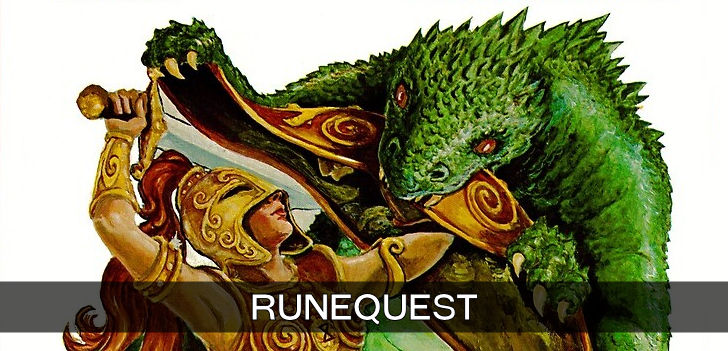
In this episode Baz and Gaz discuss the history of RuneQuest from the perspective of players in the United Kingdom, a perspective which may differ from the experience in North America. We learn how RuneQuest ended up being the alternative Baz did not choose to pursue when an opportunity presented itself.
The episode has a few memorable quips, like “the game should come with a grognard in a box” as a GM, or the Gloranthan/RuneQuest “fan base is like barnacles – you cannot shift them.”
I find it interesting that Baz did attend the German RuneQuest and/or Glorantha conventions Tentacles and Kraken without getting much exposure to the setting, but the lack of exposure to RuneQuest results from these conventions happening during the HeroQuest era, before RuneQuest and Glorantha were re-married by Chaosium. The lack of Mongoose’s Second Age Glorantha on these conventions may have something to do with the history of how our conventions spread into the UK and North America via the digests.
RuneQuest Year Zero Podcast
Guest submission by Jörg
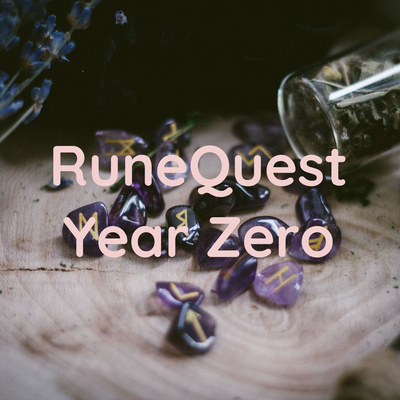
Baz continues his examination of the RuneQuest Starter Set and whether RuneQuest: Roleplaying in Glorantha hits his sweet spot.
To recapitulate Baz asked Chaosium for a copy of the Starter Set Box for this solo project of his, which he has planned to do for 101 days this year, and Chaosium complied.
The podcast is quite honest and offers a really fresh view from a long-time D&D/D20 player looking out for what makes both RuneQuest and Glorantha special, and doesn’t spare the authors from expectations not quite met or being underwhelmed by some of the content, although the later episodes slowly see the sparks draw not just smoke but also some flame.
One telling question was the question whether it was wise to produce a starter box that offers content for long-time players of the game, but as we can see from the fact that the UK warehouse completely sold out the first delivery of starter set boxes, economically this made a lot of sense as the sales volume by those old timers easily supported the probably rather marginal net revenues of this really tightly packed box. One criticism Baz mentioned about Book 4: Adventures is that the box doesn’t really address people who are new both to roleplaying/GMing and to the setting.
While he liked the first two Scenarios, I found the comparison with the D&D approach which leaves the dungeon with sessile monsters only after the DM has leveled his players and his GMing skills to level 3 rather telling. But then, Chaosium’s participation with the New Gamemasters Month is addressing exactly that problem.
Speaking of that, the New Gamemasters Month February post now is asking for feedback on a quick form, or on one of the discussion platforms. Unfortunately, those have only very few posts yet. We’d be interested to hear about participants’ experiences trying out RuneQuest, too.
Kitbashing Sable Riders
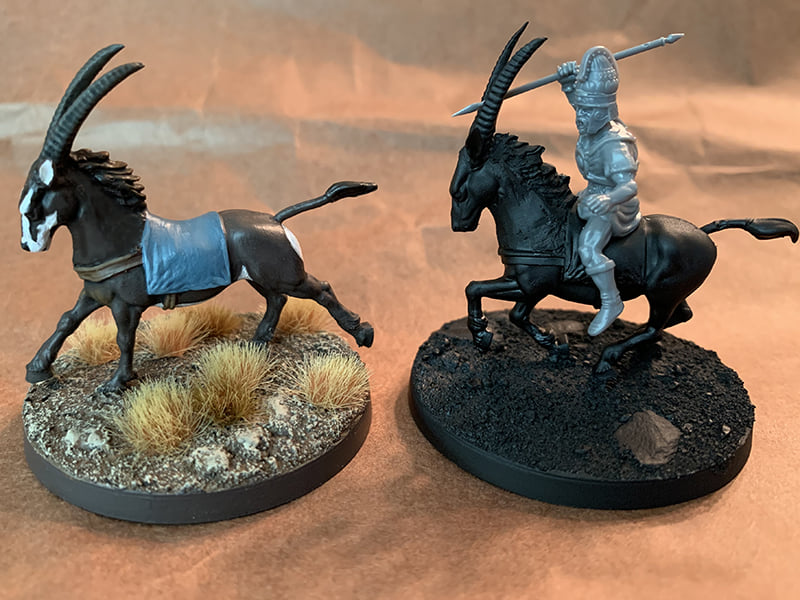
Phil Leedell is at it again!
Austin Conrad Reviews the Armies & Enemies of Dragon Pass

It’s a short but very useful review by the author of Monster of the Month (among other things) for people who don’t have this big book yet:
My favorite part of the book is how much new detail (well, new to me, anyway) it provides about Peloria and Dara Happa.
[…]
On my “tabletop/armchair” spectrum, A&E fits firmly in the “armchair” category. The gamemaster will get a lot of use from A&E—inspiring story hooks, antagonists, etc.
[…]
To be honest, if you’re going to buy only one “reference” book to support your RuneQuest collection, don’t buy the Guide to Glorantha—buy A&E. I feel A&E is more relevant to the action of an RQ campaign than the Guide, providing useful, story-generating details.
That’s pretty high praise! Read the entire review here, and get Armies & Enemies of Dragon Pass here.
Some More Zoja Barylko Art
Previously featured Zoja “ladygolem” Barylko has been drawing Rhino Riders lately, and they’re… well, I want to say “lovely” but I’m pretty sure I would get punched in the face. Check out more of her art here!
Elsewhere on Arachne Solara’s Web
Not everything is about Glorantha, although most things are! Here are loosely relevant things that we found on the interwebs.
Pentan Inspirations
I don’t know whether these pictures are staged or legit (one more here), but I think they can be used as inspiration for Pent nomad children?
For more steppe nomad goodness, you can check out the Eagle Huntress movie, about a Kazakh girl who strives to become an eagle hunter. Trailer here:
Eagle hunting in the steppes looks pretty bad-ass, so here’s some more imagery to fire up your day:
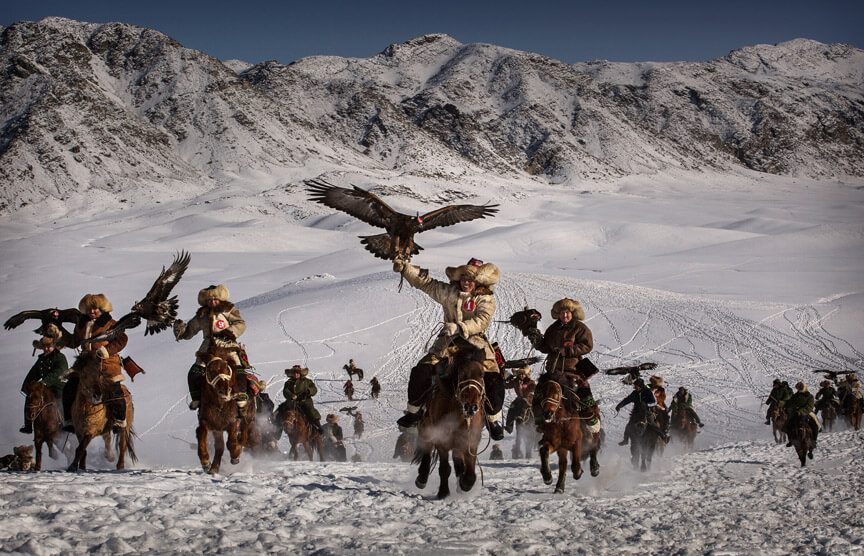
Egyptian Beadnet Dress
And now for something totally different: a 4500 year-old Egyptian beadnet dress:
Thank you for reading
That’s it for this week! Please contact us with any feedback, question, or news item we’ve missed!
Edits:
- A previous version of the article mispelled Zoja’s name.
- Bridget Jeffries was incorrectly listed as playing Vasana, instead of Yanioth.



